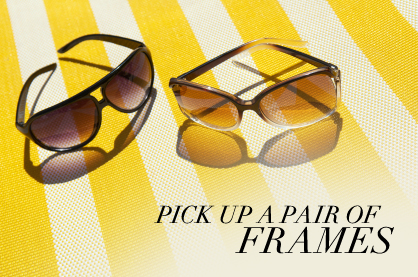Be sun smart this summer: UV eye safety tips
Summer. It’s a time to hit the beach and enjoy the long days outdoors. It’s also a time to reach for those sunglasses. UV rays can be harmful on the eyes, especially during times of warmer weather. Here’s what you need to know to be safe this summer.
The electromagnetic spectrum contains all sorts of rays, from gamma rays to X-rays. In the center of that spectrum is visible light, the color spectrum. Ultraviolet is light that goes beyond the blue end of the color spectrum. These waves don’t provide us with information as light rays do, and instead can actually damage our eyes.
Ultraviolet rays are broken down into A, B, and C types. C is the most dangerous to the eyes, but doesn’t really warrant concern because most ultraviolet C waves are absorbed by the atmosphere and don’t reach the Earth.
UV-A and UV-B are the ones to watch—but not literally. When these two types of rays enter the eye, they can be absorbed by the eye’s inner lens or by the conjunctiva, a clear membrane that covers the white part of the eye. If these UV rays are absorbed over a long period of time, they can damage the eye’s tissues, cornea and lens, causing all sorts of problems. Cataracts, cancer, blindness, age-related macular degeneration, lens deterioration and abnormal growths such as pinguecula—small yellow bumps on the eye – can all result from too much exposure to bright sunlight.
These conditions are not to be taken lightly. Pinguecula may eventually harm your vision and require surgical removal, and cataracts, a clouding of the eye's lens, can interfere with your daily activities and also require surgery to be removed.
Greater exposure leads to greater risk. Rays do not have to enter the eye directly, but can be reflected off sand, water or pavement.
“What you’re doing is adding a cumulative dose over a period of years. And as the cumulative dose adds up and adds up, the likelihood of you getting a growth or a degeneration associated with ultraviolet increases,” Dr. Lee Duffner, M.D. and fellow of the American Academy of Ophthalmology, said.
In his years of professional experience, Duffner has seen it all: people with skin cancer on their eyelids, farmers with premature cataracts from working in the sun, and individuals with sunburns on the eyelids and around the eyes.
Don’t forget the risk of skin cancer. Long-term exposure to ultraviolet can increase your chances of developing skin cancers, which can show up even on eyelids. (See LadyLUX’s article on reducing your risk of skin cancer.)
The public too often ignores the dangers of not protecting the eyes from the sun, says Duffner.
“Many people will just think it’s unimportant – ‘Oh, I don’t need to wear sunglasses.’ And then we see them in the office with a sunburn or skin cancer or a cataract … and then they rue the day they didn’t wear sunglasses,” he maintained.
So what can you do? Basically, wear sunglasses. Ultraviolet needs to be absorbed before it hits the eye.
So, the first thing to look for when buying sunglasses is whether they are UV absorbing. All sunglasses are not UV absorbing, and expensive sunglasses do not always equal good protection, Duffner cautions. There should be a sticker on the lens indicating they are UV protective – preferably blocking 100-percent of UV-A and UV-B rays. Color or darkness is not an indicator that the lenses block UV rays.
“Two things top the list when people buy sunglasses: fashion and price. Price, it turns out, doesn’t make a lot of difference, because if you don’t specifically look for those features you should have in sunglasses, you don’t necessarily have to buy expensive ones,” Duffner reported. “If there is a wonderful frame or style or so forth that you just can’t live without, people will buy it on that basis without checking to see if those lens are as protective as they should be.”
Next you should try to find lens that are polarized, which reduces glare. Wraparound sunglasses also provide more comprehensive protection, shielding you from sunlight that could enter from the sides of the face. Wearing a hat with a brim can be helpful, even if you are also sporting a set of frames.
Adults are not the only ones who need to stay out of the sun. Kids can be at risk too. Sun damage usually is the result of long-term exposure to rays, so the earlier you protect those eyes, the better.
“You wouldn’t want to expose your kids to something you wouldn’t want to be exposed to,” Duffner noted. “So for kids, sunglasses still make sense.”
And be careful on cloudy days too: Harmful rays can still pass through clouds.
So this summer, think before you walk out of the house without a pair of frames. Remember, losing your vision can be devastating. You’ll need your sight to work, read, drive and see those grandchildren.
For more information on caring for your eyes, visit EyeCare America, a public service program of the Foundation of the American Academy of Ophthalmology.
Tagged in: lux exclusives, sunglasses, eyes, sun, uv rays, uv safety, sunlight,

Purple Neon/LadyLUX via istock



